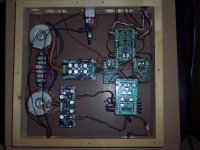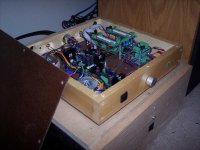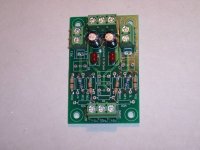COD with TXD as I/V stage
I have been listening to the COD now for a few weeks. Mostly with the passive I/V (270R resistor) into the ballsie. This sounds very good. But not really as good as the Opus.
Well I put back in the active I/V stage by putting the cap jumpers in (shorting them) and removing the resistors to GND, so that the DAC is now DC coupled to two TXDs with only THS4141s in them. This is MUCH better. Not just a little. The best way to describe the difference is just simply to say there is an apparent change in resolution. Dynamics just seem more realistic and alive.
Anyway here is how it looks in my test rig with the TXDs as I/V converters right before the ballsie.
Cheers!
Russ
I have been listening to the COD now for a few weeks. Mostly with the passive I/V (270R resistor) into the ballsie. This sounds very good. But not really as good as the Opus.
Well I put back in the active I/V stage by putting the cap jumpers in (shorting them) and removing the resistors to GND, so that the DAC is now DC coupled to two TXDs with only THS4141s in them. This is MUCH better. Not just a little. The best way to describe the difference is just simply to say there is an apparent change in resolution. Dynamics just seem more realistic and alive.
Anyway here is how it looks in my test rig with the TXDs as I/V converters right before the ballsie.
Cheers!
Russ
Attachments
Re: COD with TXD as I/V stage
When you say it's much better, did you mean in comparison to the opus or in comparison to the previous setup with the passive i/v?
Russ White said:Well I put back in the active I/V stage by putting the cap jumpers in (shorting them) and removing the resistors to GND, so that the DAC is now DC coupled to two TXDs with only THS4141s in them. This is MUCH better. Not just a little. The best way to describe the difference is just simply to say there is an apparent change in resolution. Dynamics just seem more realistic and alive.
When you say it's much better, did you mean in comparison to the opus or in comparison to the previous setup with the passive i/v?
Re: Re: COD with TXD as I/V stage
I meant better than the passive I/V + Ballsie. Though that setup is still very good!
Cheers!
Russ
neb001 said:
When you say it's much better, did you mean in comparison to the opus or in comparison to the previous setup with the passive i/v?
I meant better than the passive I/V + Ballsie. Though that setup is still very good!
Cheers!
Russ
Some one one told me this:
Voltage sources like to see a high impedance, and current source like a low impedance.
Well the TXD configured for I/V is about as low as you can get impedance wise. It just in the 10s of milliohms.
At first I was not confident this would make much difference, but it really does. Everything just seems cleaner, not colored.
With passive I/V the sound is still good, but very definitely with a "warm" coloration.
Cheers!
Russ
Voltage sources like to see a high impedance, and current source like a low impedance.
Well the TXD configured for I/V is about as low as you can get impedance wise. It just in the 10s of milliohms.
At first I was not confident this would make much difference, but it really does. Everything just seems cleaner, not colored.
With passive I/V the sound is still good, but very definitely with a "warm" coloration.
Cheers!
Russ
Now this I like! 
I decided to show the COD with TXD I/V and a Joshua Tree attenuator after each I/V, the output of the attenuator goes to the ballsie where the output is filtered and buffered. From there SE outputs go to my head amp and balanced out to the power amp.
From there SE outputs go to my head amp and balanced out to the power amp.
Oh yes, there is a metronome in there too.
Cheers!
Russ
I decided to show the COD with TXD I/V and a Joshua Tree attenuator after each I/V, the output of the attenuator goes to the ballsie where the output is filtered and buffered.
Oh yes, there is a metronome in there too.
Cheers!
Russ
Attachments
I never meant to convey that its not as good as the Opus. 
It is easily as good as the Opus. I would just say they both sound excellent. I would not say either one is "better" than the other.
The COD is certainly better now than it was with passive I/V. With the TXD doing I/V instead of the resistor the COD is a completely different beast than it was.
Cheers!
Russ
It is easily as good as the Opus. I would just say they both sound excellent. I would not say either one is "better" than the other.
The COD is certainly better now than it was with passive I/V. With the TXD doing I/V instead of the resistor the COD is a completely different beast than it was.
Cheers!
Russ
Hi Russ
How exactly do you configure the TXD as an I/V? I'm interested in trying this.
I'm also considering taking the output of the TXD (as I/V) and putting it through the Ballsie to get both differential and single ended outputs.
But, I feel like the signal's going through too many stages just to get to my bosoz and eventually the power amp.
Do you see any problems with this setup?
I'm thinking about this to save myself some of the effort of building an active I/V stage since I have the TXD boards. Passive I/V with resisitor is far from optimal as discussed in a few threads here and elsewhere (although so is using feedback but there's lots of debate about that).
How exactly do you configure the TXD as an I/V? I'm interested in trying this.
I'm also considering taking the output of the TXD (as I/V) and putting it through the Ballsie to get both differential and single ended outputs.
But, I feel like the signal's going through too many stages just to get to my bosoz and eventually the power amp.
Do you see any problems with this setup?
I'm thinking about this to save myself some of the effort of building an active I/V stage since I have the TXD boards. Passive I/V with resisitor is far from optimal as discussed in a few threads here and elsewhere (although so is using feedback but there's lots of debate about that).
HeadSh0T said:Hi Russ
How exactly do you configure the TXD as an I/V? I'm interested in trying this.
Do you see any problems with this setup?
I will be building a fresh one tomorrow, so I will take some pics and describe the process. Its very easy.
You basically just use the THS chip (I have used THS4131,4141,and 4151), 2 feedback Rs (221-390R seems to work well for me). and 4 jumpers. Its cake.
I would not interject the BOSOZ, its redundant.
I would instead just give the I/V as much gain you you think you will need, and use something like a joshua tree between the I/V and the ballsie.
I am very happy with my setup, it is absolutely silent (no hiss or noise) and the sound is superb with both headphones and through the poweramp.
Cheers!
Russ
AD1955 sounds better.ezkcdude said:I knew it was only a matter of time before you guys adopted PCM1794.
And I always found it suspicious TI doesn't put linearity graphs in their audio DAC datasheets...
Russ White said:Just for reference.
This is not a complete schematic, the buffers are missing etc. But it gives you a good idea of what I am going to do.
This is also not the current version (it is actually one of my first simulation attempts) , it is just representative...
Is this intended for I/V? If so, the input nodes should be low impedance--emitters, not bases.
Also, where's the clock? Is it on the back side of the PCB?
I would not interject the BOSOZ, its redundant.
That's what I was thinking but I use the Bosoz to allow for multiple inputs such as my cable tv receiver, Wii, and other analog sources and they all go to the power amp. So, my plan was to use the dac as just another input into the bosoz.
Maybe this will work if I set the TXD (the THS opamp) for unity gain, running as I/V and let the BOSOZ add the gain??
HeadSh0T said:Maybe this will work if I set the TXD (the THS opamp) for unity gain, running as I/V and let the BOSOZ add the gain??
It will work more than fine. I am sure it would be superb.
I would just use a lower value Feedback R for the TXD, something like 221R.
Cheers!
Russ
TXD for I/V
Here is a TXD configured for IV.
This one is using 390R resistors.
On the backsides are just THS4131,THS4141, or THS4151, any of those will work fine. In this case I happen to be trying THS4151.
Calculate the resistor for the swing (Vpp) you want by dividing Vpp by the peak to peak current swing of the DAC, in the case of the COD that is 7.8ma so I wanted roughly 3vpp so I chose 390R (.0078 * 390 = 3.042).
I hope this helps.
Cheers!
Russ
Here is a TXD configured for IV.
This one is using 390R resistors.
On the backsides are just THS4131,THS4141, or THS4151, any of those will work fine. In this case I happen to be trying THS4151.
Calculate the resistor for the swing (Vpp) you want by dividing Vpp by the peak to peak current swing of the DAC, in the case of the COD that is 7.8ma so I wanted roughly 3vpp so I chose 390R (.0078 * 390 = 3.042).
I hope this helps.
Cheers!
Russ
Attachments
- Status
- This old topic is closed. If you want to reopen this topic, contact a moderator using the "Report Post" button.
- Home
- More Vendors...
- Twisted Pear
- COD - Current Output DAC


